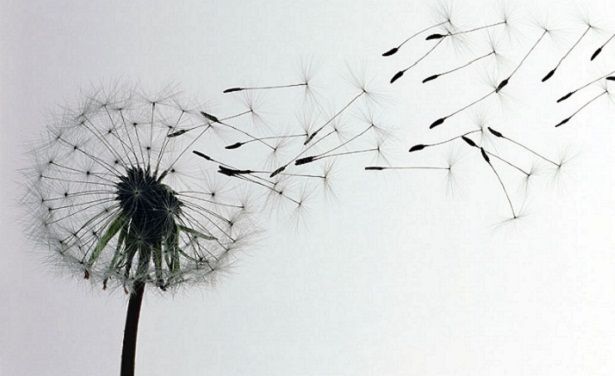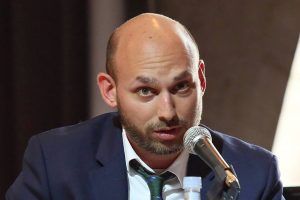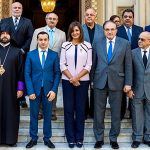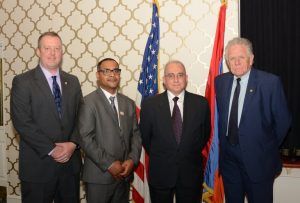Type of an Armenian: Mariam Shahinyan
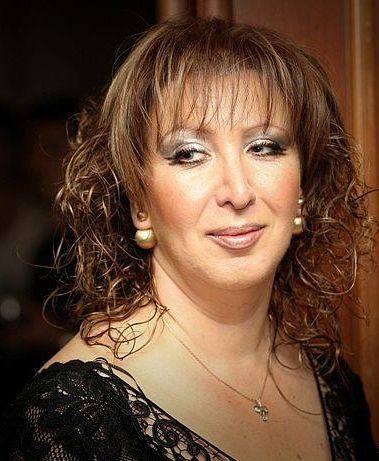
The familiar melody is heard, spreads its “wings” like a crane and takes the desired journey to the Homeland. It makes your heart beat fast and responds outside of the walls in which applause is heard, spreads, moves up and becomes a new heroic ballad of our days.
Hayern Aysor’s interlocutor is President of the “Gallery of Arts” Cultural Foundation, founder of the “National Gallery” International Music Festival and the Festival of Return Mariam Shahinyan, who has received numerous awards and certificates of appreciation, including the Gold Medal of the Ministry of Culture, the Gold Medal of VivaCell-MTS and the Komitas Commemorative Medal. She has made unwavering efforts, performed in front of packed audiences, and music has always been a part of her life.
Hayern Aysor: When and how did music become a profession and a lifestyle for you?
Mariam Shahinyan: I chose my profession when I was 6 years old, but of course, my parents helped me choose my profession, and I am grateful to them for that. At the time, I was already studying at P. I. Tchaikovsky Music School. I think this became crucial for me. Ever since then, music has been an integral part of my life. After graduating from school, I got accepted to the Piano Department of Komitas State Conservatory, graduated and started working as a teacher and concertmaster at Sayat-Nova Music School. I have combined teaching with administrative work. In the beginning, I worked in the methodology department of the Ministry of Culture and later in the culture department of Yerevan Municipality. I have also served as an instructor of Spandaryan Regional Committee. My years of experience and professional skills have allowed me to develop and implement cultural programs on my own. I have been working independently for the past thirteen years.
Hayern Aysor: You are the president of the “National Gallery” International Festival for classical music for over a decade. How did you come up with the idea of intertwining two branches of the arts and presenting classical music at the National Gallery?
Mariam Shahinyan: Since 1998, I have served as an assistant to the principal conductor, office director and music editor for the Armenian National Philharmonic Orchestra. Since I was zealous towards various festivals that are being held abroad and not only in classical music concert halls, but also in non-traditional concert halls, I came up with the idea of organizing a festival in Yerevan that would feature concerts in the frescoes hall of the National Gallery of Armenia. The synthesis of color and sound conveyed new air to classical music. The festival was loved and accepted by the audiences. Over the years, it grew and gathered more and more audiences. In fact, the people in the audiences were not only professional musicians, but also people with different professions who would wait for the concerts with pleasure. Every concert would gather foreign musicians and pave the way for implementation of new and joint creative programs.
The audience named the festival as a spring celebration.
Hayern Aysor: In 2007, you launched the “Return” Festival. How was it received? What were the reactions from Armenian music lovers and Armenian musicians living abroad? How has the festival developed over the years?
Mariam Shahinyan: The success of the “National Gallery” Festival, the great reactions and positive feedback of the audiences led to the creation of another classical music festival called the “Return” Festival, which the audience viewed as an autumnal celebration. The idea is already reflected in the name of the festival. It was a call to all Armenian musicians of the world who have left Armenia throughout the years for different reasons, achieved success and have become internationally recognized to return to the stage in Armenia, even if it is temporary. The concerts of the festival have featured performances by world famous musicians such as Sergey Khachatryan, Sergey Babayan, Suren Bagratuni, Vardan Mamikonyan, Vahan Martirosyan, Varduhi Khachatryan, Juliet Galstyan and other renowned musicians.
All the musicians who have been the guests of our festival and who are applauded in the most prestigious concert halls, state that they feel the most responsible when performing in Armenia. This is in some way a report on their past activities for the Armenian audience.
The geography of the participants of the festival expanded over the years. Later, the musicians would return with their foreign colleagues and participate in the concerts together. Once again, Armenia was becoming recognizable on the world map as a country with a great historical heritage and as a center for the arts and culture.
Hayern Aysor: How do you organize festivals in the regions?
Mariam Shahinyan: The festivals are not limited to a concert series in Yerevan. We have never overlooked Armenia’s regions. Unfortunately, people in the regions are not culturally active. Due to that, we have included as many concerts and events as possible for people in the regions. There have always been master classes, as well as concerts in various cities across the republic. We have held concerts in Gegharkunik region, Gyumri, Vanadzor, Artik, Gavar and elsewhere.
Hayern Aysor: Organizing a concert or festival implies a lot of preparatory work, especially when we talk about long-term projects. Who helps you carry out these projects?
Mariam Shahinyan: A project can remain an idea, if it is not supported. VivaCell-MTS has supported us for years. In 2007, the “National Gallery” Festival was included in the list of state support programs of the Ministry of Culture. I don’t like to talk about hardships at all. I think there are hardships in any field, but they can be overcome. When you love what you do and are devoted to your job, the result is clear to see.
Hayern Aysor: Alongside world famous Armenian musicians and performers, we Armenians also have a new generation of talented young musicians. I know that you also reveal and present young performers during festivals and provide them with the opportunity to perform on stages in Armenia and abroad.
Mariam Shahinyan: Talented young performers have been presented through the Young Talents of Armenia Program, which is one of the features of the “National Gallery” Festival. The participants were the students of music schools in not only Yerevan, but also various regions of Armenia. Among the participants were teen musicians from Vanadzor, Gyumri, Ararat, Abovyan and more. Today, those teens are successful musicians, recipients of international awards and perform in various countries. They are Mane Galoyan, Narek Kazazyan, Liparit Avetisyan, Nina Minasyan, Davit Melkonyan, Gurgen Baveyan, Hasmik Torosyan and others.
In 2007, I received an interesting offer. Chairman of Hayastan All-Armenian Fund’s London affiliate Armine Karapeti suggested presenting this program in London as well. The program was carried out until 2015 and was later turned into the Talents of Armenia Program.
Hayern Aysor: How do you see the role and weight of an Armenian woman in our reality today, including in the arts? How do you manage to be extremely womanly and well-preserved in spite of your busy schedule? What is the formula of your success?
Mariam Shahinyan: Although I highly appreciate the role of a man in all spheres of life, a woman is the one who can be very delicate, as well as see and notice things in politics, culture and community service that a man might not see. An Armenian woman is first and foremost a mother and then a woman and figure. With little time and a tight schedule, an Armenian woman mobilizes her forces and can be everywhere. No matter what, that is what is good (this is my motto in life). I live and work with pleasure and am dedicated to my job.
P.S.: Our online interview ends, and I become convinced once again that we Armenians are strong, presentable and competitive with our arts and our dedicated artists whom the whole world applauds. Hardships can be overcome when the goal is to make your art and culture accessible and recognizable in the world and when you are a part of endless music that is referred to as the Type of an Armenian.
Interview by Aghavni Grigoryan




 Արևելահայերեն
Արևելահայերեն Արևմտահայերեն
Արևմտահայերեն Русский
Русский